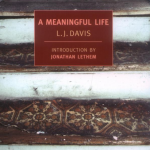Bruno Alexander, the central character of Jonathan Lethem’s novel “A Gambler’s Anatomy” is a professional gambler – backgammon is his game of choice – who grew up in California but now travels the world. His shadowy controller, Edgar Falk, arranges games with wealthy men who feel they’ve learned enough to play Bruno for hundreds (of dollars or euros) a point. Bruno works the odds, and the doubling cube, and usually walks away with a great deal of money.
When the novel opens, Bruno is in Germany. On a ferry to an opponent’s lakeside house, he meets a woman, Madchen, whom he chats with and intends to call – she gives him her number before they part. To Bruno’s surprise Madchen turns up again later that night. It’s good she’s there, because Bruno has a seizure mid-game, and winds up in a hospital where he’s diagnosed with a meningioma, a tumor of the membranes that cover the brain. Bruno’s tumor is behind his face, and causes a blot in the center of his vision.
Blots are bad: a man-made structure is a blot on the landscape, or one blots one’s copybook or escutcheon. In backgammon a blot is a risk: it’s a single stone left unprotected on the board. (If you need a refresher on the rules of backgammon look here.) The blot has caused problems for Bruno, including an unprecedented losing streak to a player in Singapore, Keith Stolarsky. Stolarsky is not a stranger to Bruno, who was two years ahead of him at Berkeley High School.
After a week in the hospital Bruno finds himself on a plane home to Berkeley, where Keith, who paid for the plane ticket, meets his plane. Keith arranges an apartment, clothes, and walking-around money while Bruno awaits surgery. Keith is able to do that as he’s been buying up Berkeley real estate, monetizing the area’s anti-capitalist and student mindset.
Without thinking much about it, Bruno undergoes a phantasmagorical advanced surgery, in which his face is peeled away like a mask and a specialist neurosurgeon who loves rock and roll removes the film of tumor. The surgery consumes the central section of the novel, and it’s the one part that feels researched and a tad forced. Afterwards, of course, things are not the same for Bruno, and he puts the smarts and insight that once supported his backgammon career to other uses.
Those other ends are two-fold – Bruno slowly unveils his past as the only child of a single hippie mother and finds that her example has influenced him in ways that perhaps he hadn’t considered. Bruno spends the rest of his time tracing Keith’s neighborhood-sized empire.
Which leaves the reader with questions to contemplate: Why does Bruno value the blot that transformed his brain and altered his vision, especially after it’s gone? And why is Keith willing to underwrite Bruno’s treatment? Lethem’s power is such that there are several possible answers to each of these questions, leaving the reader thinking about this novel long after finishing it. If you have a theory about who the gambler of the title is, by all means let us know in the comments.
Alexandra Bowie is a writer living in Brooklyn. Have a book you want me to know about? Email me at asbowie@gmail.com. Follow me on Twitter @abowie917.


